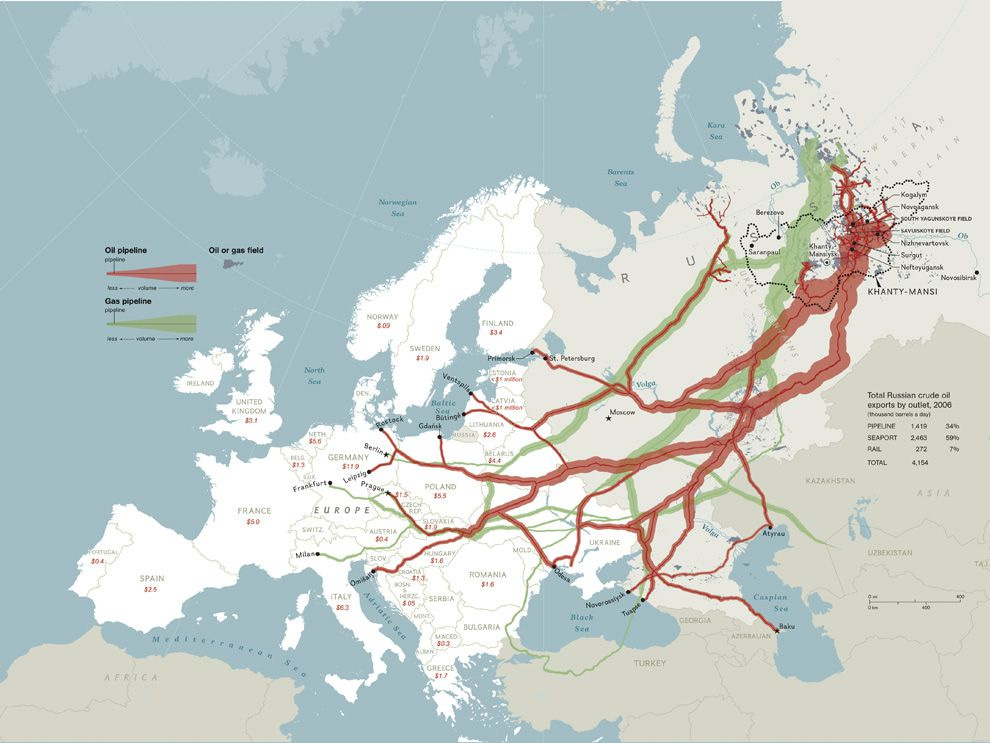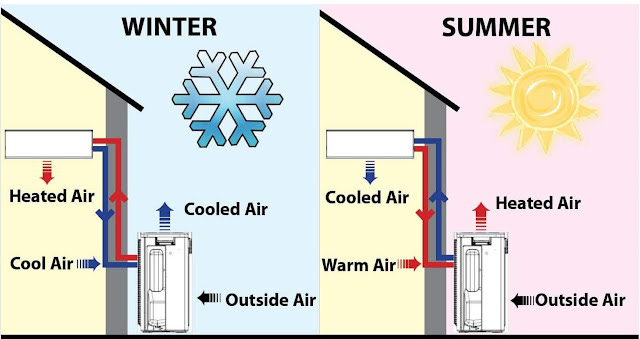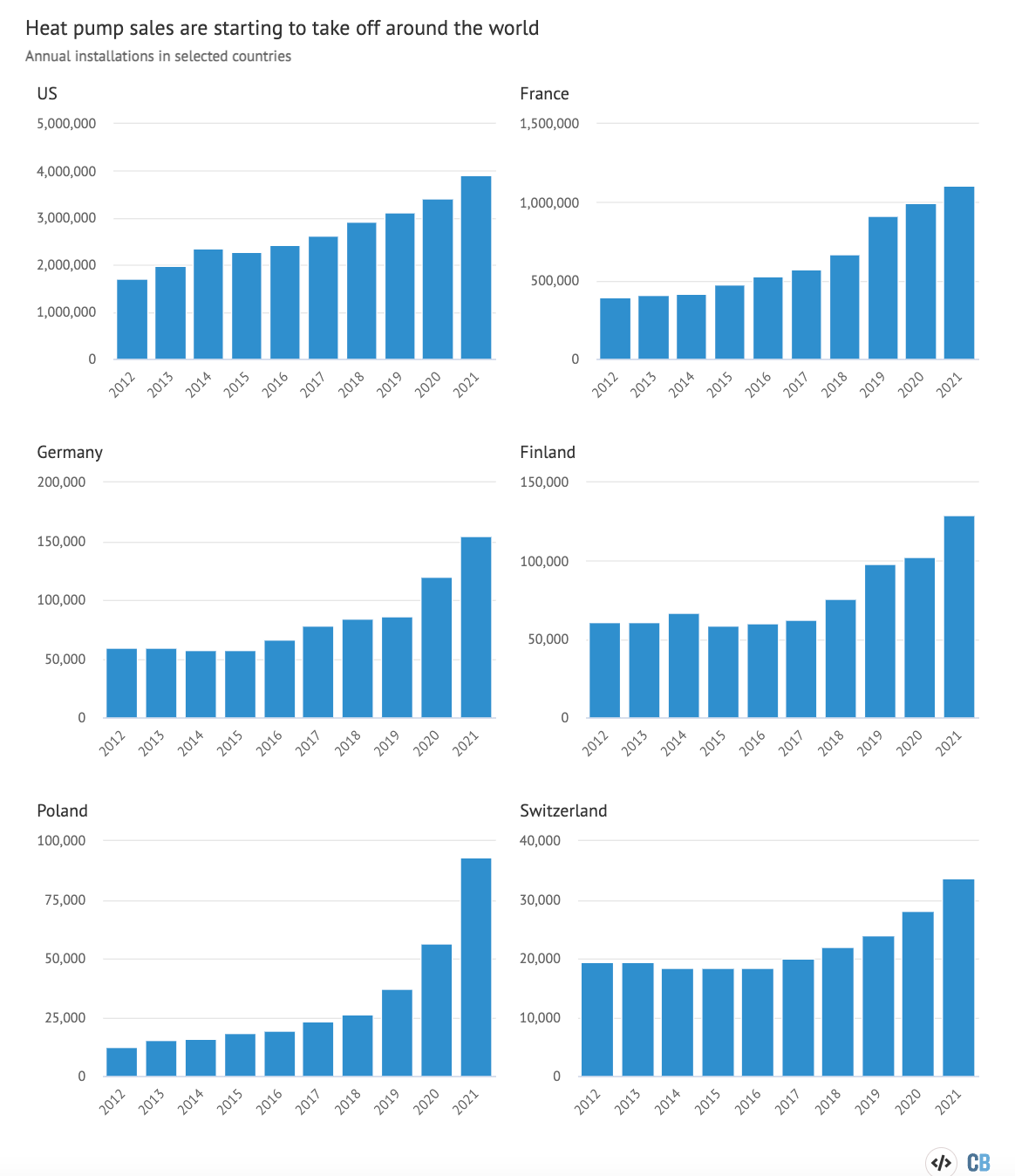Year 2049 is the weekly newsletter that discusses the impactful innovations and discoveries shaping our future.
If this was forwarded to you, subscribe for free to get a new story in your inbox every Friday.
Hello friends 👋
The French government announced that it was ending its subsidies for gas heaters in an effort to reduce its reliance on Russian gas. Instead, subsidies towards cleaner solutions like heat pumps will be increased by 1,000 euros.
Heat pumps deserve so much more attention than they actually get, so I’ve summarized everything you need to know about them.
Read along and enjoy!
– Fawzi
Today’s Edition
Comic: The sad life of an outdoor heat pump unit
Story: Heat pumps and their untapped potential
Visualization: Humanity today vs humanity’s past
Comic
Story: Heat Pumps and their untapped potential
The unhealthy dependence on fossil fuels

The EU’s reliance on Russian gas has been problematic for years, even more so since the start of the devastating war in Ukraine last month.
A few weeks ago, the EU announced their plan to cut its reliance on Russian gas by two-thirds this year and end it “well before” 2030 (Reuters). The EU currently relies on Russia for 40% of its yearly gas imports.
France quickly announced that it was ending subsidies for gas heaters. Instead, it’s boosting funds towards its “MaPrimeRénov” subsidy program to encourage its citizens to transition to cleaner sources of energy in their homes, like heat pumps and biomass heaters.
Not only can this greatly reduce energy dependence on Russia, but they also have significant environmental benefits. 2 birds, 1 stone.
Heat pumps are a few years behind electric vehicles but really deserve similar attention and could deliver very sizable reductions in emissions if we deployed them much more rapidly.
– Jan Rosenow, director of European programs at the Regulatory Assistance Project, in an interview with WIRED.
Heat pumps 101
Heat pumps are meant to replace heating and air conditioning solutions that are powered by fossil fuels. At first glance, they look like your traditional AC units. But the way they work is quite complex.

The simple explanation:
Instead of generating heat like a traditional heater or furnace would, heat pumps exchange heat between the indoor and outdoor environments through an indoor and outdoor unit:
In the winter, heat from the outdoor air is pushed inside.
In the summer, heat from the indoor air is pushed outside.
This is a high-level explanation of how an air-source heat pump works. There are also ground-source heat pumps that can run on geothermal energy: they operate on the same principle of exchanging heat between the indoor air and Earth’s crust.

The detailed explanation:
The physics behind this is quite complex and I’m not the best person to explain it. If you’re interested, I highly recommend watching this 10-minute video explaining how heat pumps exchange heat and how this can be reversed during the summer and winter. If you prefer reading, you can check out this explanation instead.
The massive potential of heat pumps
Heat pumps only account for 7% of global heating used in buildings according to the International Energy Agency:
In 2020, electric heat pumps still met no more than 7% of heating needs in buildings globally, yet they could easily supply more than 90% of global space and water heating at a lower CO2 emissions level – even taking the upstream carbon intensity of electricity into account – than condensing gas boiler technology.
This map from the IEA made me realize the untapped potential of heat pumps in reducing emissions if they were deployed at scale:
Air-source heat pump CO2 emissions reductions by country relative to the most efficient condensing gas boilers, 2020

The good thing is that heat pump sales are rising around the world, but the IEA says that more efforts are required.

Challenges and solutions

While heat pumps have clear benefits compared to traditional heating/cooling solutions, there are still a few bumps in the road before they hit their inflection point:
Costs: heat pumps are pricier than traditional HVAC solutions and can cost up to $8,000.
Difficult to install: installing a heat pump requires a trained professional.
Not enough installation experts: there’s a shortage of people who know how to install heat pumps.
However, I went down my research rabbit hole and learned about different solutions to each of these challenges:
Reducing costs:
Government grants and subsidies: We talked about France increasing its subsidies for heat pumps. In Canada, the government is offering up to $5,600 in grants for people to make their homes more energy-efficient under the Canada Greener Homes Grant. China, the US, the UK, Ireland, and more countries are also offering grants, subsidies, or tax credits to accelerate the adoption of heat pumps.
Rental/Leasing model: Delta-EE, an energy research and consultancy firm based in Scotland, has proposed creating a rental/leasing model which they believe can make the economics more attractive and remove any perceived risks associated with switching. They call this model heat-as-a-service.
Easy installation: Ideally, heat pumps should be as easy to install as an IKEA bookshelf. Gradient, an SF-based startup, is creating a heat pump that can be self-installed with no professional help. You can learn more about it on their website.
Training more experts: I’ve found some affordable heat pump installation training programs online, but I’m not an expert so I’m not sure how good they are. Maybe this is your cue to start a heat pump installation training business.
Final thoughts
I’m optimistic about the future of heat pumps: the technology is improving, costs are coming down, and new policies are accelerating their adoption around the world.
If you happen to live somewhere where your government is giving subsidies to install heat pumps, they’re definitely worth exploring. The upfront costs might be higher, but heat pumps require less energy to operate than traditional heating and cooling solutions so you’ll save some money on your monthly bills.
What do you think of heat pumps? Leave a comment and let me know 👇
Deep dive
If you enjoyed today’s story, I’ve compiled some additional links to satisfy your curiosity:
Factbox: Europe's plan to wean itself off Russian gas (Reuters)
A detailed global analysis of heat pumps (International Energy Agency) – highly recommended
Visualization: humanity today vs humanity’s past
Previous episodes you might enjoy
🚗 The 6 Levels of Driving Automation, simply explained
🛒 Tally, the grocery store robot
🦾 Atom Limbs and the quest for better prosthetics
You can also check out all previous Year 2049 editions in chronological order to learn about other impactful innovations shaping our future across all aspects of life.
How would you rate this week's edition?







Here in Australia, not all Heat pump products are available for government subsidies and rebates and not all states offer rebates. Good thing that 1 state offers subsidies on solar and heat pump hot water system of about $1,000 assistance. I’ve read it here: https://www.energy.gov.au/rebates/solar-and-heat-pump-hot-water-system-rebate. To confirm this, I have found out that this really is true since it is already on Wiseliving’s website: https://www.wiseliving.com.au/hot-water-heat-pump.
I used to have heat pumps. Despite claims from the "experts" they don't work when the outside temperature reaches 3 to 4 degrees C. The air being sucked in has heat removed from it which takes it below dew-point, so the moisture settles out. This then freezes as heat is being removed from it, resulting in a huge block of ice on the exchanger coils.
Therefore, no more air flow to take heat from. No heat in the house.
I clearly remember listening to the cracking as the ice melted during the warmth of the following day. And the bills from my indoor electrical heater for the evenings.